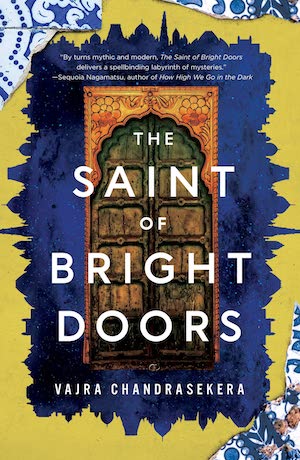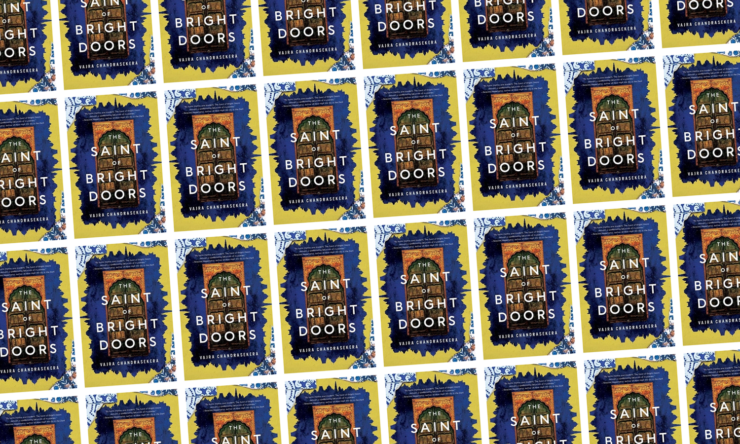“Fetter isn’t even the only feral child of a messiah in his social network.” This is not the first sentence of The Saint of Bright Doors, but it effectively sets the scene—at least for a while. Vajra Chandrasekera’s immersive debut passes through coming-of-age territory and reshapes itself into stranger terrain: a mystifying prison landscape, a place of prophets who can rewrite the truth of the world, a city of mysteries only somewhat solved.
Fetter was once a child raised for his mother’s crusade, a weapon shaped by her anger. As a young man living in a city that changes at the whims of the rich and powerful, he knows a lot of unchosen ones; he met them at a support group. But only he is the son of the Perfect and Kind, the messiah whose divided religion is at once all-powerful and the kind of thing that needs a crowdfunding campaign.
Also, he doesn’t have a shadow.
The loss of Fetter’s shadow is where his story begins, at his birth, when Mother-of-Glory snags it on a nail and tears it from him. It is a visible sign of all the other things she does, teaching him “gramarye, dialectics, revanche, deferral, and murder” and training him on the Five Unforgivables that are the heart of his father’s “ideological apparatus.” When he’s a teen, she makes him lunch and sends him out into the world with a final lesson: “The only way to change the world is through intentional, directed violence.”
Buy the Book


The Saint of Bright Doors
Years pass in the turn of a page, and then Fetter is in his early twenties, living a directionless but pleasant life in the city of Luriat. There, he spends his days helping other newcomers, going to his support group, and dating a man much higher up the class ladder than he. Status is power in Luriat; everyone has an ID card “laminated in plastic and bearing the relevant sigils of power and strings of haecceity that give access to Luriat’s services.” It’s not just who you are; it’s what you are, what level, what caste, what religion, that grants—or refuses—access.
It is hard not to want to describe large parts of the story of The Saint of Bright Doors, simply because it is so fascinating, so resonant, so rich. The support group! The powers and bureaucracies! The stories that shape the world, possibly—probably—literally. It’s a vivid dream of fantastical realism, a world in which nothing is like our world, except everything is like our world, from the competing religions to the fascism, the tangled apparatus of government, the way a city might provide a home one day and disappear a person the next.
Fetter gets involved with a group of revolutionaries; Fetter gets to study the bright doors of the title, Luriat oddities which form when a door is left closed. Where they are doors to, or from, is only one of the book’s mysteries. This is a story of unexpected perspectives, ever-shifting, slippery even for those who live in it. What stories render a chosen one unchosen? When there are many chosen ones in a room, are they chosen again by the fact of being in the room? What defines a prison? If you are told you’re in a prison but while there you get a job and live a “productive” life, where does the prison really end?
What gets left behind, and where does it go? What do you need to know about a person to understand why he’s doing what he’s doing—and whose perspective are you seeing him from?
The Saint of Bright Doors is a book that requires you to sit with questions, with uncertainties, with betrayals and cruelties and terrible moments that are no less terrible for being so plainly observed, so matter-of-fact in their telling. Chandrasekera writes his way through this fantastical world in a beautiful, clear voice that observes things carefully, from a slight distance, and with an appreciation for the mundane. There are messiahs, but there is also junk e-mail. There are pogroms and programs, ID cards and men with voices that can send you straight into a vision. Fetter’s mom calls a lot on the landline he forgot about, even when it isn’t plugged in. She tells him the rest of his history, her history with his father, and the things no one else remembers. Who shapes the world, and who tells the stories about how it’s been shaped?
Unexpectedly, The Saint of Bright Doors reminds me somewhat of the early work of Magnus Mills, whose unsettling novels always seem to start in a recognizable place before taking you to quite another, even if you’re still just in a small village. A surrealness, a focus on freedom, on the way the strange can become ordinary or vice versa—that’s what these two have in common, though their works are literal worlds apart.
Or not so far apart. Chandrasekera writes:
He found it charming at first, how unremarkable his shadowlessness is in this city, but he’s come to see it as part of a deep Luriati unwillingness to acknowledge anything that would require overturning their world, whether in physics or politics. A crowd like this wouldn’t acknowledge the fact of a hinterland pogrom or a prison camp either. To them, such things are the invisible laws and powers of the world, to be left unseen or at least not looked in the eye.
The invisible laws and powers of the world. There are other “invisible” laws and powers in this world, though only Fetter can see them. There is so much that people, in general, wish not to see. You don’t have to have read the author’s short introduction to an excerpt elsewhere on this site to sense that his story was written as a pandemic settled into the bones of our world, and people did not want to look. People still do not want to look.
Like The Archive Undying, like The Spear Cuts Through Water, The Saint of Bright Doors is a story about how people—specifically men, in these three novels—can be shaped and betrayed by the same forces, and how they might unpack, untangle, or walk away from their pasts. All three reject the mythos of the one special man, the person with the most power, the single spear, though they do it in wildly different ways. One of those ways is by stepping aside, outside of the understanding of others. Chandrasekera writes, late in the book after Fetter walks away from a shocking scene, “Fetter is not legible, and so he is not read.”
“Not legible” is an idea that also arises in a poem by Megan Fernandes, who writes, in “Letters to a Young Poet”: “It’s better to be illegible, sometimes. Then they can’t govern you.”
What freedom is there in not being read, in being unknowable, in a society that wants to box and categorize and rank everyone? What tools of the powerful can be rejected, refused, reversed? How can a single 400-page novel have between its covers so many ideas that every time I think about it, I want to pick it up again? It’s rare—and wonderful—to read a novel that feels at once utterly of another world and entirely of our own, a heady brew of the intimate and wild and wise and questioning. It’s the kind of book that might just change the way you read.
The Saint of Bright Doors is published by Tordotcom Publishing.
Read an excerpt.
Molly Templeton lives and writes in Oregon, and spends as much time as possible in the woods. Sometimes she talks about books on Twitter.










